Homeward Bound – Ospreys on the Move
It’s only a matter of time now before we bid a fond farewell to our osprey youngsters LP8 and LR0 here at Loch of the Lowes, therefore it seems like a good time to take a look back at the incredible journey that lies ahead of them.
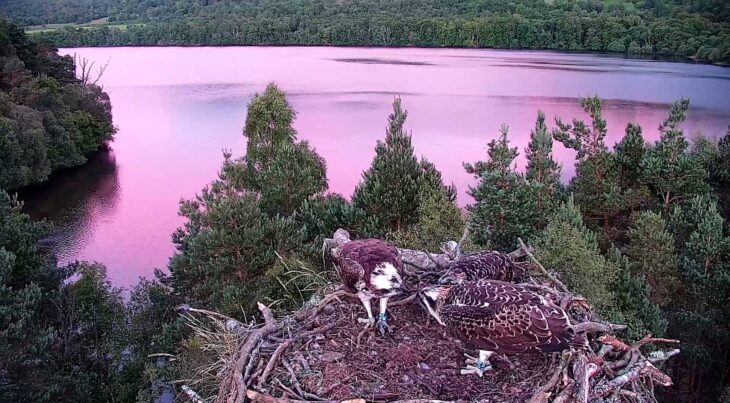
Ospreys are a migratory species, meaning that they travel long distances north to reach their breeding territories in the summer and then head south to their wintering grounds at the end of the season, a round trip of some 12,000km.
UK ospreys migrate along the ‘East Atlantic Flyway’, a route that takes them over England and then usually over western France, then Spain or Portugal. They often cross near Gibraltar, then hug the African coast to their eventual destination, as too far inland means crossing the Sahara, with their final destination being the west coast of Africa to locations such as Gambia, Guinea Bissau and Senegal. However, we are seeing an increase in the number of ospreys being sighted wintering in Portugal and the south of Spain, no doubt an indicator of climate change.
Most ospreys take between 4-6 weeks to make the journey in autumn but are considerably faster on the way up in spring, since the breeding instinct is strong and they must get to their nest before any interlopers. They can fly at considerable heights, regularly covering over 100km a day or even flying non-stop for 48hrs! They will stop many times on route and can spend up to a week or more on a particularly good estuary or river, especially if weather is unfavourable. Young birds make more stops, learning to fish effectively for the first time on their maiden journey, and will wander more before settling down to habitual yearly pattern.
In the past some ospreys have been tracked and monitored using GPS units that are attached like a small backpack when the young osplets are ringed at around 5 weeks old. One such bird known as ‘Rothiemurchus’ visited the nest at Lowes earlier in the season.
‘Rothie’ was satellite tagged by Roy Dennis in 2009, and his movements were observed via his GPS for 5 years. ‘Rothie’ and other sat tagged birds have provided insight into the migratory route choices young birds take, and how these change as they become more experienced.
Since ospreys migrate alone, a juvenile’s first migration is an extreme challenge, indeed 70% of ospreys are known to die in their first few years, with migration being the biggest challenge they face, since they must learn the best routes, fishing and resting spots as they go.
The best refueling locations and safest crossings over bodies of water are all learned and refined throughout the course of their first few migrations. These ‘choices’ can be seen clearly when looking at ‘Rothie’s sat tag data below. In his first migration he only just survived being blown out into the Atlantic, before making it to Portugal and then later Senegal. Similarly, when he returned north for the first time he was pushed off course to the west, and later in the season made the risky open water crossing of the Bay of Biscay.
In subsequent years he appeared to hone his migration route, opting to hug the coast and minimise flying over the sea where more turbulent conditions, dangerous winds and poor thermals make for dangerous journeying.
Rothiemurchus migration routes 2009-2014 (orange=autumn, white=spring) © Roy Dennis Foundation
It is incredible to think that these young birds, who some 13+ weeks ago were wee ‘bobble heids’ on the nest, will make this journey entirely alone. We still do not know exactly how they navigate – probably some combination of visual clues, since we know they fly more in good clear weather. Genetic instinct and probably some form of geomagnetic perception that we do not yet understand are also likely to play a large role.
Only a small handful of ospreys are tracked using GPS, however any ringed birds in the UK receive a small metal ring with a unique code and most will also receive a large Darvic colour ring with a combination of two or three numbers or letters. This is placed on the left leg of a Scottish osprey and the right leg of an English or Welsh bird.
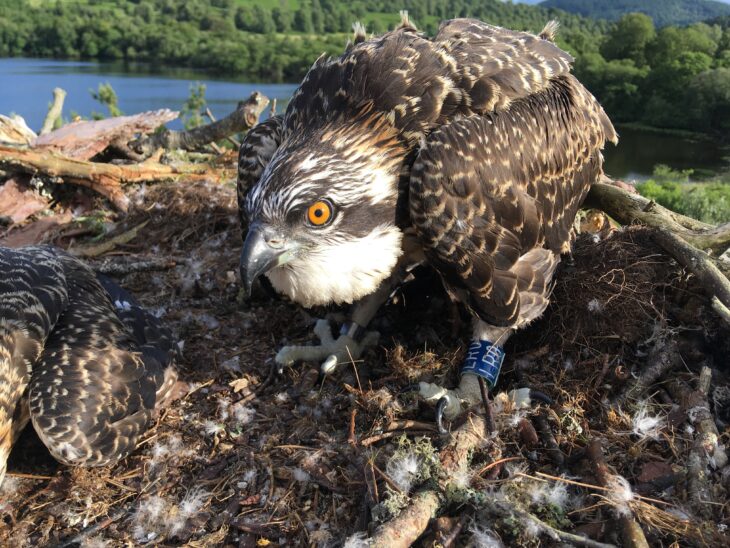
This enables anyone with a good pair of binoculars, telescope or camera with a large lens to contribute to their identification and mapping of sightings, particularly at this time of the year when ospreys are on the move, and youngsters may spend substantial time perfecting their fishing technique before mustering up the courage for their first flight across the English Channel. Any sighted birds can be reported to the Roy Dennis Foundation and the data collated has enabled conservationists to build up detailed mapping of osprey recovery, distribution and breeding grounds over the years.
Recent sightings of Lowes ospreys over the years can be seen in the map below.
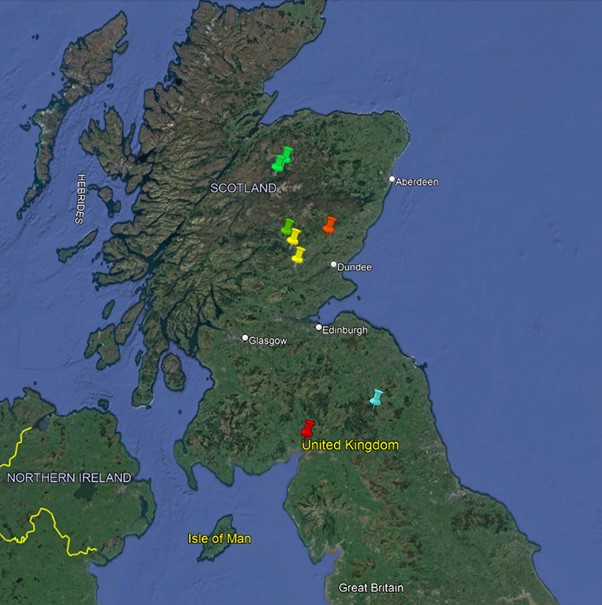
We know that a large part of ospreys’ migration to hotter, sunnier winter locations is based on instinct. The same can be said of their return flight north again, to breeding grounds where the longer daylight hours and abundance of fish provide the perfect conditions to raise hungry osprey chicks.
It is this instinct that brings them back to the region they fledged from as youngsters, on the look out for a nesting site or partner of their own. We have seen many of our ospreys over the decades return to nesting grounds not far from our own nest – with some nesting in Angus and the wider Perthshire area. Sometimes however, they come a lot closer to home…
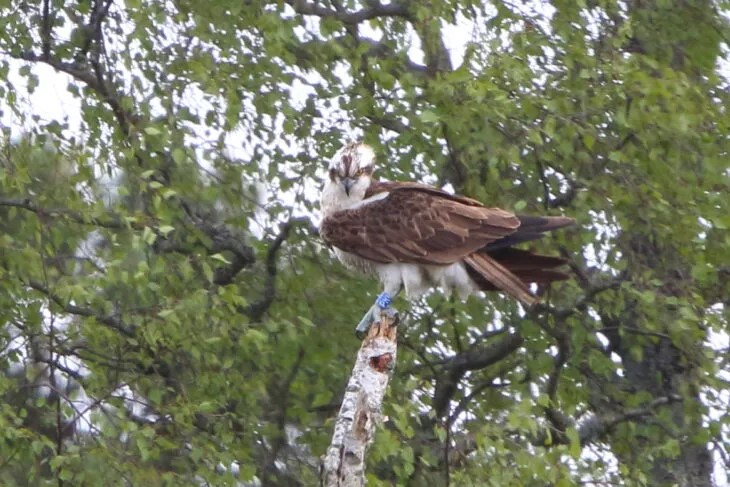
PH1 is a male osprey who fledged the nest at Lowes in 2017. Two years later in 2019 he was seen at the top of a split birch tree, a favoured perch for the resident osprey family. He appeared during a period of time in May when the resident male LM12 – who is still our male today – was away from the nest. But PH1 wasn’t the only Lowes chick to return. In 2001, a hatchling from 1995 who was ringed Yellow US was also seen briefly at the nesting site. Whilst they did not stay for long, or assert themselves on the nest in a bid to oust the resident adults, it’s still marvellous to see how instinct brings fully-grown raptors ‘home’.
Whilst males are more likely to return to their fledging grounds, female youngsters tend to roam more on the hunt for the perfect nesting site and partner, and will make a bid for any nest that takes their fancy. This year, our 2019 female fledgling PH4 has been observed on a nest with her new partner Blue Y1 in Kielder Forest! An exciting piece of news that will hopefully result in a successful breeding season in the summer of 2023.
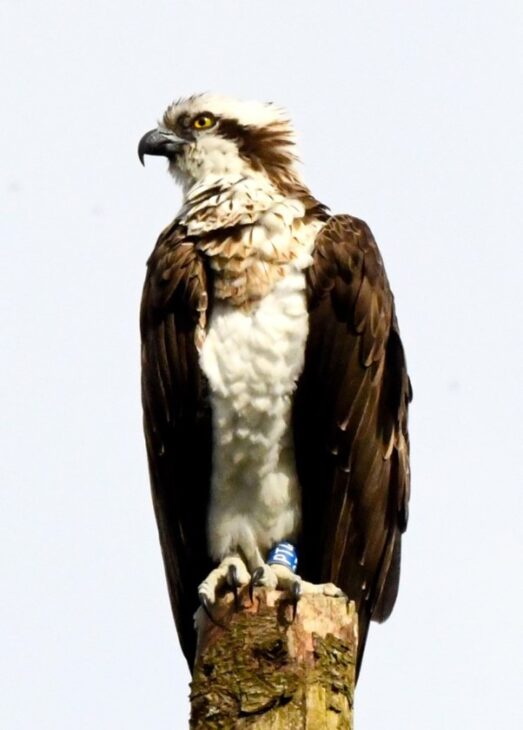
So as a wee nip returns to the air, the leaves begin to turn and the ospreys and other migratory species make their long journey south, keep your eyes to the skies, and do report any sightings to the Roy Dennis Foundation.
You can also follow the journey of three ospreys from the Tweed Valley known as ‘Tweed’ (Blue 706), Kirk (Blue 707) and Glen (Blue 707) who have been satellite tagged as part of an initiative led by Conservation Without Borders to study the dangers facing young osprey on migration. This short video below explains more about this important project.
Don’t forget to keep tuning into the webcam for those last glimpses of our osprey family. They wont be here for much longer! here. Follow us on Twitter or Facebook for regular updates.
Charlotte Needham & Raz Rasmussen
Seasonal Assistant Ranger & Perthshire Ranger
The Trust’s Osprey Protection Programme at Loch of the Lowes is supported by players of People’s Postcode Lottery.
Help protect Scotland’s wildlife
Our work to save Scotland’s wildlife is made possible thanks to the generosity of our members and supporters.
Join today from just £4 a month to help protect the species you love.
Preface
It’s only a matter of time now before we bid a fond farewell to our osprey youngsters LP8 and LR0 here at Loch of the Lowes, therefore it seems like …
